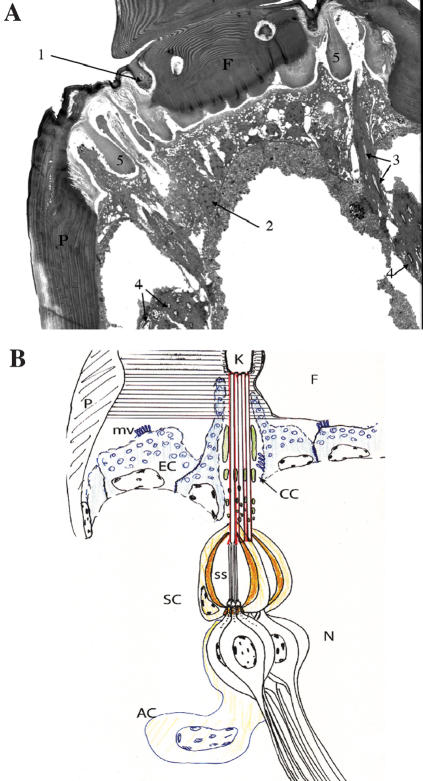Figure 2.
Organization of the honey bee JO. (A) TEM picture of the honey bee JO is shown. The morphology and positions of the cuticular knob (1), epithelial cell (2), quasi-longitudinal section of long sensory processes (3), quasi-transverse section of scolopidia (4), soft chitin (5), pedicel (P), and flagellum (F) are indicated. (B) The summary of the ultrastructural analysis of the honey bee JO is shown. At the joint of the pedicel (P) and flagellum (F), the cuticle is organized in a complex pattern of radial fibrils (horizontal lines), with circular fibrils surrounding the cuticular “knobs” (K) to which the scolopidia are attached. There are approximately 48 knobs evenly distributed around the circumference of the flagellum at its joint with the pedicel. Epithelial cells (EC; blue) exhibit extensive apical microvilli, likely for the copious secretion of cuticle proteins. The epithelial cell cytoplasm is filled with spongiform membranous organelles, likely also reflecting high secretion levels. Each cuticular knob is the attachment site of 3–10 scolopidia. Each scolopidium forms an independent dendritic cap (red), and these are surrounded by cap cells (CC) which enclose electron dense rods (green) that are thick apically but divide more basally into multiple finer rods. The scolopale cell (SC) of each scolopidium forms a spindle-shaped cage of scolopale rods (organe) and encloses an extracellular scolopale space (ss), through which the ciliary outer dendritic segments of three neurons (N) extend. Morphologically, honey bee JO scolopidia are amphinematic, containing cilia of both Types I and II (see classification described in ref. 30). The two Type I cilia are of uniform diameter, contain an axoneme along their entire length, and attach to the basal end of the dendritic cap; the single Type II cilium contains an axonemal segment up to the dendritic cap, then a wider non-axonemal segment with loose microtubules that continues throughout the length of the dendritic cap. Basally, there are accessory cells (AC) of uncertain classification. The structure of the honey bee JO is consistent with a sensory function for flagellar vibration.

